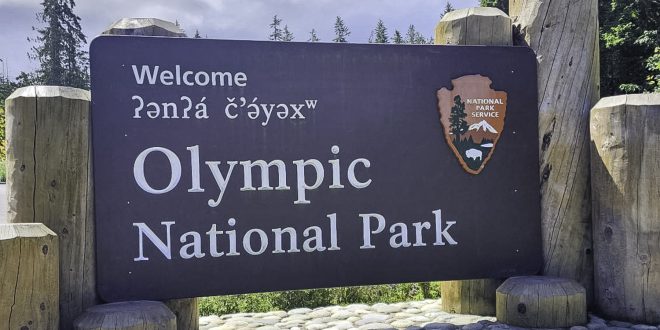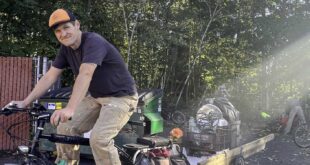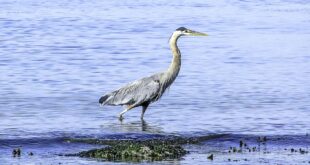One of the first things I spot when entering Olympic National Park is the gray shirt, dark forest-green trousers, gold national park badge, and iconic flat-brimmed hat of a park ranger in uniform. I have to wonder: What is it like being a ranger? What makes up their typical day?
On a mission to find out, I call the park office and connect with Jeff Doryland, who discusses park ranger roles with me. “I’m in the facilities department,” Doryland says, “so I work in the administration building. The rangers you’re probably thinking about work at the park entrance, or the Visitor Center, or at campgrounds.”
The National Park employs all rangers; each wears the uniform, but their jobs can be vastly different. There are maintenance staff, interpretive rangers, rangers who work in the Wilderness Information Center, administrative staff, trail maintenance crews, and the list goes on. I decide to follow up on three park ranger roles: backcountry, law enforcement, and interpretive/education.
Josh McLean, Backcountry Park Ranger
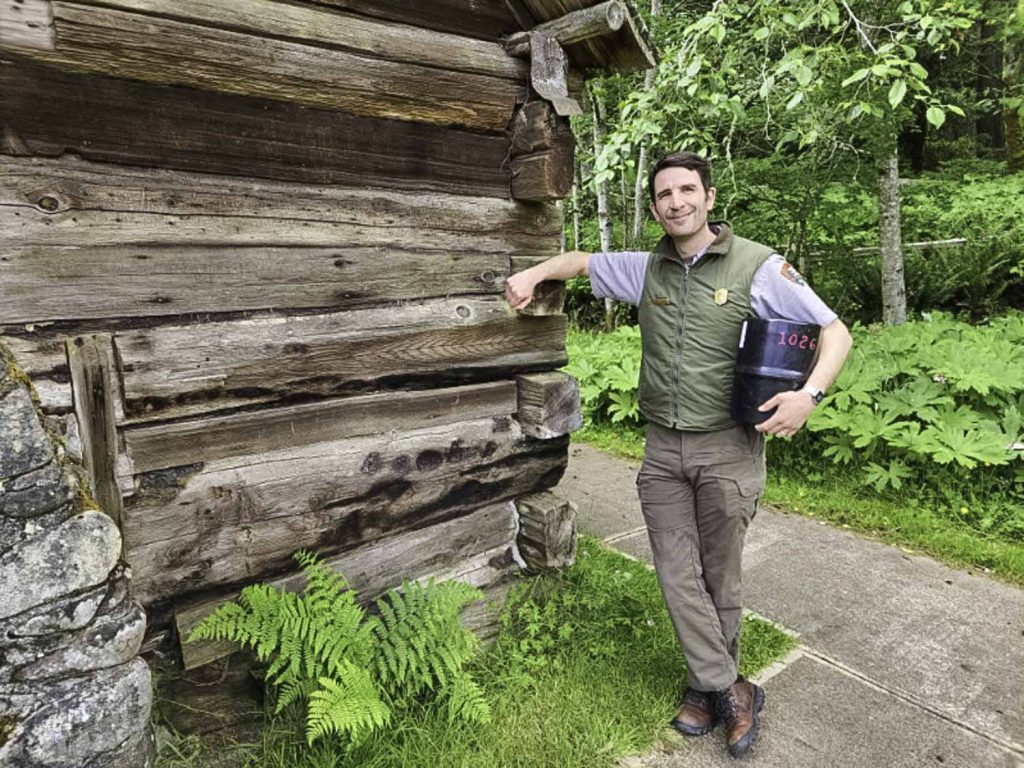
“I grew up in Alaska and had a high school teacher who was once a park ranger,” Josh McLean says. “She was inspiring, and it sounded like the work would tap into my interests: being outdoors, working with the public, speaking to groups. It was very much a traditional park ranger job she portrayed.”
After beginning as an interpreter at Humboldt Redwoods State Park in California, McLean moved to work with students through the NatureBridge program located within Olympic National Park. Over the course of eleven years, he worked part-time and then eventually full-time into a position as a backcountry ranger. His official job title now is “wilderness information assistant.” McLean splits his time between working at the backcountry information counter at the park Visitor Center and actually being in the backcountry.
At the Visitor Center, McLean meets with individuals planning backpacking and hiking trips; he issues permits, gives out bear canisters, goes over maps, and answers questions.
“People often start by asking me, ‘Where should I go?’ so we discuss how many miles they might want to cover, the elevation gain, crossing streams and rivers, and snow-covered trails. We talk about what they’re capable of and what they would enjoy taking on. The rest of the time, I’m in the field.”
Sometimes visitors remark, “Oh, you get paid to hike around in the park?” Actually, the work involves campsite rehabilitation, helping with search and rescue, and other related duties. “I could be sent anywhere in Olympic National Park. I’ve probably got one of the most broad-based jobs here.”
McLean’s two roles are very much related. McLean does PSAR (preventive search and rescue) when he’s at the Visitor Center. He’ll ask people if they have experience navigating in rough weather, can find trails in snow-covered areas, and are equipped for ascending steep, rugged terrain. “I need to explain the hazards and try to exercise diplomacy with my questions while emphasizing safety.”
McLean regards this as one of the best parts of his job. “I love talking about the Olympic wilderness and sharing some of my favorite spots. I have the background and experience, and it feels good to use that expertise to enhance someone’s time in the park.”
McLean remembers being at the ranger tent at Royal Lake, which is more than a seven-mile hike into the backcountry. It was raining hard. Around dusk, two hikers in T-shirts and shorts arrived. They looked miserable.
“I helped them find a campsite, but later, both were standing outside my tent. ‘We can’t get our tent pegs into the ground,’ they said, so I came back out and helped them set up their tent. Not long after that, they were back. ‘We can’t get our stove going.’ I came out again and assembled their stove, then got it started.”
The weather cleared the next morning, and McLean was excited to tell them about hiking opportunities.
“You’ve got to do the hike just above the lake,” he told them. “It’s gorgeous.”
“Thanks for your help,” they replied, “but we’re leaving.”
“We’re here to help . . . but I guess sometimes our perceptions and hikers’ perceptions can be a little different,” McLean says. “But the nature of our work is down to that most essential component—to try to help.”
McLean mentions one other backcountry duty: cleaning pit toilets. He does that—a lot. When people see him doing this job, they know he is doing work of value, work no one else wants to do and work that needs to get done.
“They’re called ‘composter toilets,’ but it’s not as though they magically turn human waste into gardening soil. My tools are a sixty-gallon barrel, a shovel, and a pair of thick rubber gloves. The full barrel gets flown out of the park.”
There are 165,000 backcountry “camper nights” (the number of nights people occupy campsites) a year. The park wouldn’t hold up against the impact of that much use without the backcountry rangers’ help. Human waste can carry pathogens that the park doesn’t want to end up in the watershed, so cleaning toilets is an inarguable service. It all gets back to helping people enjoy the park.
“As rangers, we have a passion for this place. This is our home. We’re in love with the wilderness… and that’s why we do what we do.”
Doug Geehan, Law Enforcement Park Ranger
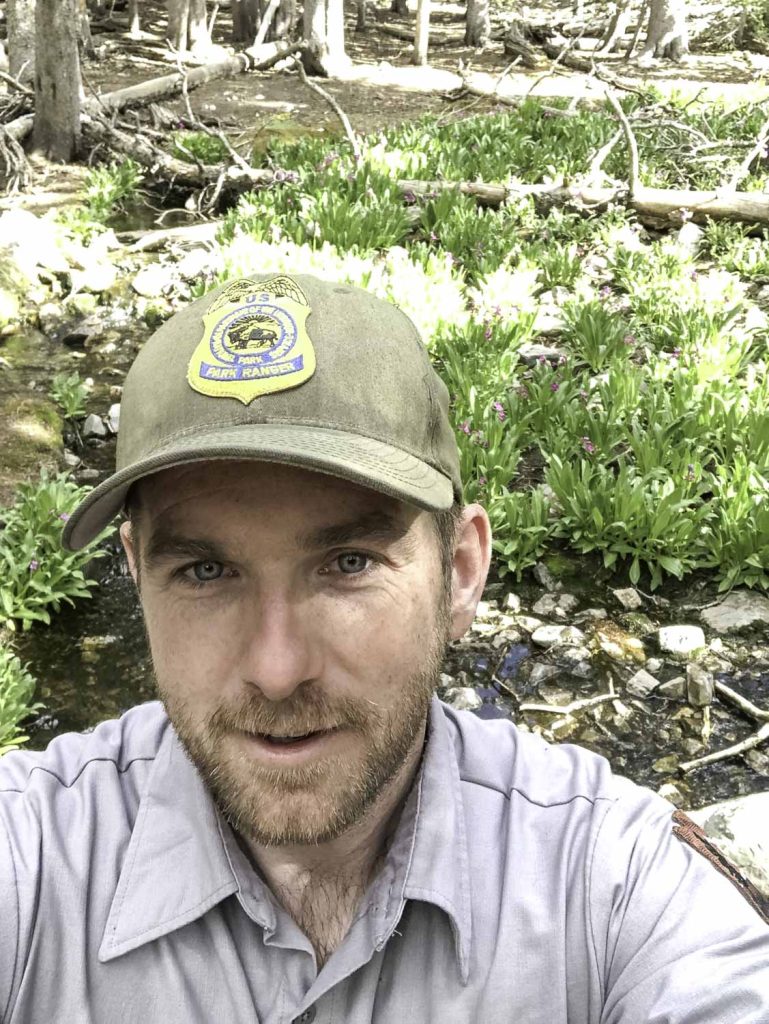
“I’m from the East Coast. I was an English and creative writing major,” Doug Geehan recalls, smiling at the memory. Eventually, after different jobs and a couple of moves, he entered the Park Ranger Law Enforcement Academy Training Program, which led to seasonal park work in Death Valley. “I loved it!”
Once prospective rangers complete the training program, they’re eligible to apply for seasonal positions with the National Park Service. Most new hires spend two or three years in seasonal employment before finding a permanent park job.
“I’ve always enjoyed the outdoors, but that really grew once I came out west.” Olympic National Park is especially inviting, providing work in dramatically beautiful surroundings, as well as a nice quality of life. And it’s close to town.
Every park is its own place, so law enforcement rangers do different things in different parks. In Olympic National Park, there is no “typical day.” About 50 percent of Geehan’s job involves law enforcement, and the other half involves EMS (emergency medical services), backcountry work, and search and rescue. He also has his wildland firefighting credential.
As trained law-enforcement personnel, these rangers are the legal authority in their jurisdiction. They do investigations ranging from assault to vehicle break-ins to timber theft. But Geehan’s favorite part of the job is search and rescue. “We work as a team, and when we’re successful, there are just so many positives about it. We found them!) and for a moment, you get to be a hero.
“I remember getting a backcountry call when I worked at Sequoia National Park. An extremely fatigued hiker was experiencing altitude sickness.” Geehan’s crew scrambled into a helicopter and went on high alert as they received reports that the hiker was getting worse. Quickly.
“Rescue can have an element of risk that you have to weigh: Is it safe to take a helicopter up in these weather conditions? Can we land on this terrain? To save a life, you go.”
They moved quickly, were dropped into the backcountry, and located the hiker, getting to her just as she stopped breathing. “We immediately loaded her into the copter and got her on oxygen. Lifting right off, we dropped in elevation, and she started to come around.”
The average national park visitor doesn’t encounter, or even consider, rangers in law-enforcement roles. “The general public is always surprised by us,” Geehan says. “They see us and say, ‘Guns? Body armor?’ Thinking back, I guess I was surprised, too, when I first heard about the role.” However, the perception of the work park rangers do is changing.
“For me, it’s not so much about being a ranger as it is about being a problem solver.” Law enforcement rangers have to think on their feet, be able to pivot, and immediately come up with the best action plan for a specific situation. “The work is hard. We take it seriously.”
Taking the helicopter rescue Geehan mentioned as an example, that person would likely have died without the rangers’ intervention. “When things go right, everyone’s glad it worked. Positive public support is reinforcing, but the feeling you get from a successful rescue? That’s amazing.”
Jamie Shurnitski, Interpretive Park Ranger
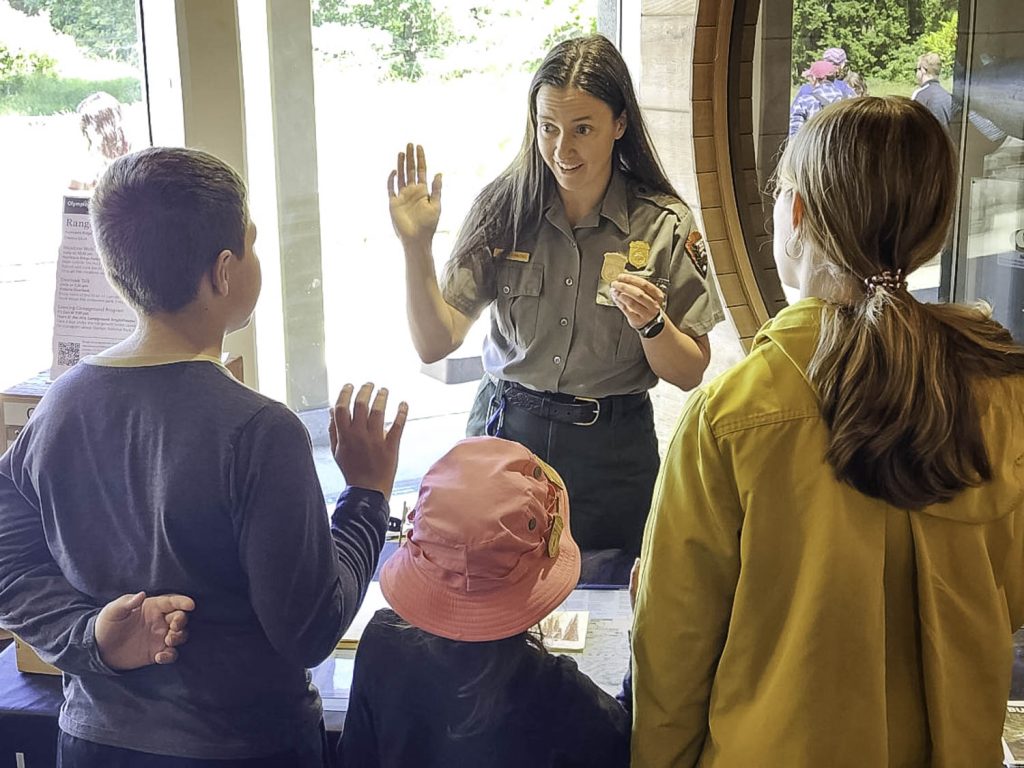
“I was in college in Maryland,” Jamie Shurnitski says, “and I started working with the parks through AmeriCorps.” She began on a trail crew and thoroughly enjoyed the work. From there, she began doing seasonal work as a student trainee, eventually working at Death Valley, Crater Lake, and Katmai National Park in Alaska.
Though she enjoys working outside, Shurnitski became an interpretive ranger at Olympic National Park. She fell in love with the job: welcoming visitors and talking with them about what they’d like to see. Olympic is a huge park, and planning can be overwhelming, so Shurnitski’s job is to help visitors get organized and enjoy their time. “I want them to head out excited and prepared.”
But not all of Shurnitski’s work happens at the Visitor Center. During the summer, she guides meadow walks on Hurricane Ridge; in winter, she helps guide snowshoe walks on the ridge. “That’s definitely one of my favorite activities: it’s free, open to anyone, and the snowshoes are provided!” People get to experience winter in a different way. Shurnitski guides people who are usually new to snowshoeing and initially feel out of their comfort zone, but they’re all doing it together and end up having fun.
Shurnitski also assists with evening campground programs. At the Heart O’ the Hills Campground, which boasts one of the best preserved old-growth forests in the park, one such program is called “The Secret Language of Trees.” It’s all about how forests communicate. “People are interested, they ask good questions, and they obviously like being here,” Shurnitski says. “It’s one of the times I tell myself, ‘I love this job!’”
Shurnitski also runs the Junior Ranger program. “I meet with youngsters and talk with them about their time here in the park. They’re curious, they share their thoughts, and they always have such good questions. I help them take the ‘Junior Ranger pledge’ and award them their badge. That’s one of the best parts of my day.”
Shurnitski began with the perception that being a park ranger was an outdoor job, but now she knows it can be a very public role. There is value in both, and her role as an interpretive ranger can directly impact someone’s experience in the backcountry.
“There’s so much to see here. I’ve worked at Olympic for three years, and there are still parts of the park I have yet to see. People initially want to see the whole park in one visit, but that simply can’t be done, so I try to help them slow down and focus on enjoying one spot.” When they do that, they’ll see things they might otherwise have missed: trees, plants, animals, geologic features. And, of course, they can always come back for more.
Park rangers, regardless of specialty, are dedicated individuals committed to being good stewards. “Whatever our role, whatever we do,” explains Jeff Doryland, “we’re all working to support the mission of the park. That is, to preserve—unimpaired—the natural and cultural resources and values of the park system, for this and for future generations to enjoy.”
We need our National Park Rangers!
Parks cannot function without appropriate staff, and President Donald Trump’s recent executive orders eliminating thousands of federal employee jobs threaten park services and access. 1000 National Park Service (NPS) employees have been terminated (alongside 3400 United States Forest Service employees). Parks were already understaffed. Since 2010, the NPS workforce has decreased by 15%. At the same time, park visitation has increased by 16%.
 Mike Nolan is a freelance writer living in Port Angeles, WA, where the mountains meet the sea. His writing has appeared in The Seattle Times, Peninsula Daily News, and other publications. Visit him at mikenolanstoryteller.com.
Mike Nolan is a freelance writer living in Port Angeles, WA, where the mountains meet the sea. His writing has appeared in The Seattle Times, Peninsula Daily News, and other publications. Visit him at mikenolanstoryteller.com.
 AdventuresNW
AdventuresNW


